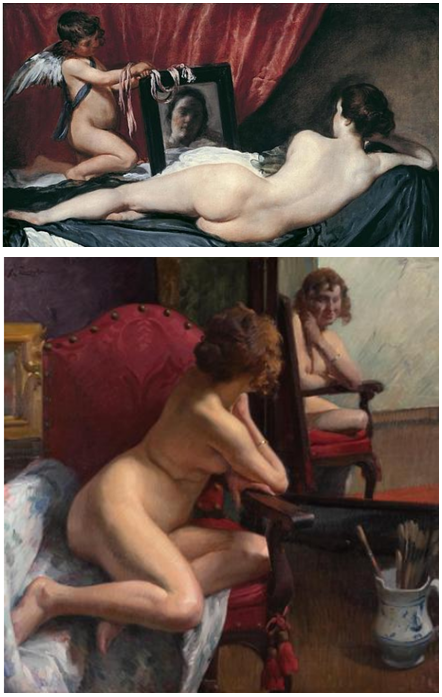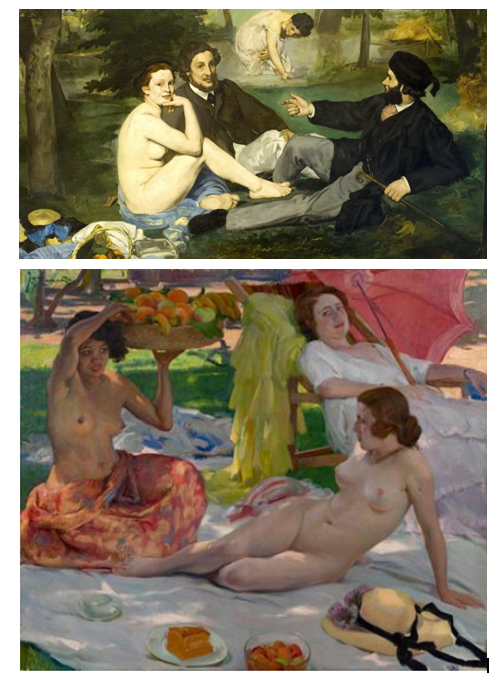José Ramon Zaragoza and the beauty of the female nude.
The beauty of the female figure in all its registers has been the object of representation from the beginning of art history to the present . However, from the eighteenth century, its presence was accentuated, especially from a new, more realistic perspective away from the prototypical images until then associated with the appearance of the Virgin Mary, a saint or heroine. With the arrival of realism and impressionism, artists became interested in achieving a greater effect of naturalness in their works through genre scenes in which women became the undisputed protagonist . An example of this are the two pieces by José Ramon Zaragoza that will be put out to tender on April 15th in our modern and contemporary art auction in which the Asturian painter represents the splendor of feminine beauty. These two monumental pieces, in addition to being exhibited in the exhibition held in Madrid “A century of Spanish art 1856-1956” in 1956, were part of the most recent retrospective that, as a tribute, they held in their hometown of Cangas de Onís in 2008.
An indefatigable traveler, he toured almost all of Europe in his eagerness to get to know directly the works of the great masters of painting, visiting museums and exhibitions that served him to make some of his best compositions. After visiting Rome, Paris, London, Strasbourg, Brussels and several German cities, he returned to Madrid with a fully consolidated style in which female portraits together with rural and traditional scenes will be his most remarkable and admired legacy. In his artistic background we can trace the multiple and varied influences that Zaragoza absorbed as a result of his travels, being common to find in his paintings, multiple references and winks to those artists who, such as Gaetano Previati, Velázquez, Murillo, Sargent or Sorolla accompanied him to throughout his career shaping his artistic imaginary.
In “Female Nude in Front of the Mirror”, Zaragoza represents the female body in a scene that we can relate to the iconographic tradition of the “Venus of the mirror” initiated by Diego Velázquez . In fact, this would not be the first time that the painter ventured into this type of scene, as confirmed by the copy of the natural that he was able to make on his trips to London of the majestic Venus del Espejo, by Velázquez, at the National Gallery. Zargoza uses the resource of the mirror with a loose compositional skill to include a double perspective that broadens our spatial field and reveals hidden parts to us. Resolved under the naturalistic language that characterized her, she surrenders to the absolute enhancement of feminine sensuality, giving the model an elegant but suggestive gesture, which envelops in an intimate atmosphere of calm serenity. The velvety light, modeled with a soft realism, does nothing more than recreate the resounding and suggestive beauty of the body.
The expressiveness of the long and loose brushstroke, the saturation of the color, and the compositional balance are harmoniously combined both here and on the canvas “Nudes” , in which Zaragoza offers us an exuberant country scene in which he introduces the female nude, in a nod to Manet’s famous painting “Breakfast on the Grass” with which the French painter, scandalizing all the members of the Academy, would be rejected at the Paris Salon. Starting from this daring treatment of the manners theme, Zaragoza develops the scene in a clearly impressionist plastic language, both in the exultation of its chromatic palette, and in the skillful light treatment, in which the shadows abandon their dark tones, to immerse themselves in a vivid colorful. Likewise, the comforts of bourgeois life, which he portrayed on so many occasions, are reflected here, through the two female figures that appear in an idle attitude while a third holds them a basket overflowing with tropical fruits.
Throughout his prolific career, Juan Ramón Zaragoza took his work throughout Europe, accumulating behind him multiple exhibitions, awards and recognitions that place him as one of the most prominent costumbrista painters of 19th century Spanish art.



